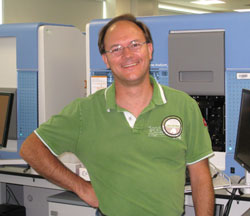
Dr. Dirk J. Evers
Director, Computational Biology
Illumina, Inc.
Computational Biology is defined as the science of understanding complex biological phenomena by the analysis of multi-sample and multi-variate quantitative data. With the advent of high-throughput measuring devices, particularly the new generation of DNA sequencers, the cost of generating data has dropped several orders of magnitude during the last 10 years. There is no sign of this trend slowing down. What will be the effect of cheap, fast, simple, robust, high-quality DNA sequencing? Computational Biology applications will become ubiquitous. It is well-known that Biotech and Pharma have been utilizing Computational Biology approaches successfully for some time, but now we see the technology and research spreading into industries such as Environment Management, Agrotech, Biofuels, Personalized Medicine and Consumer Genomics, to name just a few.
In preparing this keynote I perused keynote contributions in previous editions of the ERCIM news. Here are some of the recent topics: Simulating & Modelling, Digital Preservation, Towards Green ICT, Future Internet Technology, The Sensor Web, Safety-Critical Software, and Supercomputing at Work. It is very clear that the advances described therein are of fundamental importance if Computational Biology and Molecular Biology are to achieve their full impact in the coming years. We will succeed only if we can acquire samples ubiquitously, simulate and model precisely, compute efficiently and safely. We must also archive the high volumes of data efficiently while providing authorized and fast access, and present the data via the Internet in a meaningful way to all interested parties. Computational Biology is an interdisciplinary science by definition. Nonetheless, it is clear that the future complexity of this scientific area and its technology goes well beyond the core definition given above.
There is a strong European tradition of Computational Biology and Bioinformatics going back to the inception of the first Bioinformatics curriculum by Prof. Robert Giegerich (Bielefeld University, Germany) in the late 1980s which I was lucky enough to attend. Of course, research in Mathematics and Informatics for Biology and Biochemistry goes back much further than that, with too many prominent examples to single out any one specifically. EU funding organizations will need to take great care and oversight to compete successfully with North America and China in this space.
To be clear, in the next decade the impact of this science on government decisions as well as personal lifestyle and medical decisions will be profound. The EU, governments and societies will need to ensure that they are prepared for future advances in high-throughput instrumentation and Computational Biology. Research organisations and industry will have to provide safe technology and robust data interpretation. Educational institutions will need to update curricula to enable graduates, medical doctors, and scientists to harness the new technology and scientific findings at their disposal.
Computational Biology Scientists beware! Your science is leaving the safe haven of Research-Use-Only to applications of widespread public use.
Dirk J. Evers
{jcomments on}









